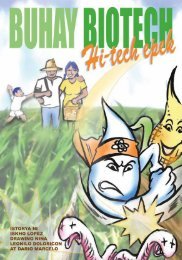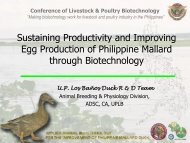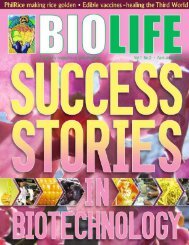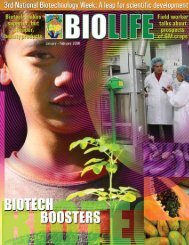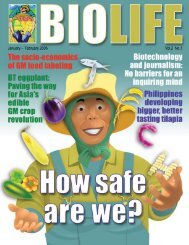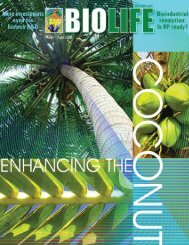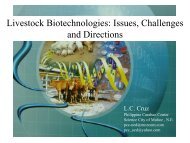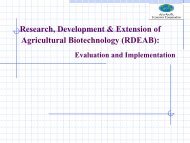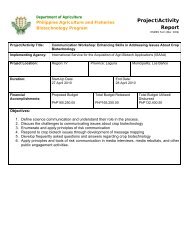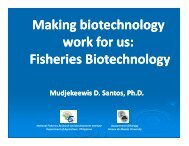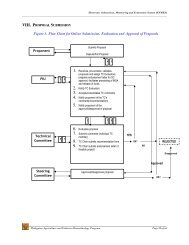Download PDF - SEARCA Biotechnology Information Center
Download PDF - SEARCA Biotechnology Information Center
Download PDF - SEARCA Biotechnology Information Center
Create successful ePaper yourself
Turn your PDF publications into a flip-book with our unique Google optimized e-Paper software.
10 BIO LIFE January – March 2005<br />
Bt cotton:<br />
an alternative<br />
high-value crop<br />
By GAMALIEL TEJADA<br />
‘H<br />
OW much will I gain if I plant cotton’<br />
is the immediate question of a farmer<br />
enjoined to grow cotton by a field worker of<br />
the Cotton Development Administration<br />
(CODA). It’s not surprising that this becomes<br />
the primary concern: as the cost of fertilizers,<br />
chemicals and labor escalates, farmers<br />
want to squeeze whatever meager profit they<br />
can out of growing a certain crop, be it cotton,<br />
tobacco, rice, or corn.<br />
Under current practice in growing cotton,<br />
the net cash income is as low as P1,250<br />
a hectare. This is based on the 2001/2002<br />
cotton season’s national average seed cotton<br />
yield of 1,030 kilograms, total production<br />
cash cost of P20,350 a hectare, and P20<br />
a kilogram of seed cotton.<br />
While a homegrown technology for growing<br />
cotton is in place to obtain optimum yield<br />
and income, farmers are going beyond<br />
what’s recommended, especially in pest control.<br />
Cotton bollworm, the most destructive<br />
of cotton pests, accounts for a big chunk of<br />
total pest-control budget. A cotton farmer<br />
would often spray pesticides 8-11 times in<br />
one hectare—which costs him P6,400.<br />
Besides entailing high cost, this practice<br />
of extensive spraying puts the farmer,<br />
his family and community at risk. The danger<br />
to the environment of non-judicious<br />
use of chemicals has been extensively<br />
documented here and abroad——contaminated<br />
water supply, air pollution, not<br />
to mention the resulting health ailments,<br />
among others.<br />
The increasing problems from chemical<br />
use have prodded scientists to keep seeking<br />
efficient and safer means of production<br />
in agriculture and fishery.<br />
One noteworthy product of this endeavor<br />
is a biotechnology product called Bt cotton.<br />
Transgenic plant<br />
Bt cotton is a transgenic plant, i.e., developed<br />
through genetic engineering. With<br />
its built-in ability to control the cotton bollworm<br />
and other sucking pests, it has highly<br />
improved cotton production in 16 Bt cottongrowing<br />
countries, among them Australia,<br />
Canada, Argentina, India, Indonesia, Thailand<br />
and the United States. Higher productivity<br />
and greater socioeconomic advantages<br />
are among the documented benefits.<br />
The Philippines is in a position to enjoy<br />
similar benefits with the commercial planting<br />
of Bt cotton. Calculations made by CODA<br />
experts——toxicologist Dr. Aida Solsoloy,<br />
and Dr. Edison C. Rinen, breeder and director<br />
of the Cotton Research <strong>Center</strong>—show<br />
that introducing Bt cotton in the country will<br />
increase farm level yield to 3,000 kilograms<br />
per hectare; reduce cost of chemicals to<br />
P1,600 (from the average P6,400 for spraying<br />
8-11 times) and raise net cash income to<br />
P40,770 per hectare.<br />
According to Solsoloy, even if the Bt cotton<br />
seed is more expensive than currently<br />
recommended cotton cultivars, this is augmented<br />
by the increase in yield and lower<br />
pest control cost.<br />
In sum, the promise of Bt cotton may be<br />
summed up thus: high yield plus low production<br />
cost equals high profit and a healthy<br />
environment.




